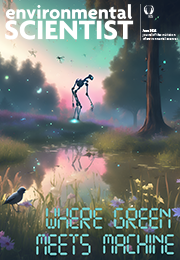Innovations in AI, machine learning, and other digital technologies are already offering enormous benefits for environmental science, and for the health of our ecosystems. Yet with these opportunities comes a significant amount of environmental, social, ethical, and existential risk. How do we navigate the rising CO2 emissions from artificial intelligence, while supporting its use for optimising adaptation to a changing climate? How should environmental professions be adapting to the rise in digitisation of traditionally hands-on work, and how can we support new environmental science research in areas of digital technology that are evolving so incredibly quickly?
In this issue of environmental SCIENTIST, our contributors explore the dilemmas that are tangled up with innovation in digital technologies and the environmental sciences. Showcasing some of the most exciting use cases of new digital innovation – from augmented reality and machine learning for wildlife conservation, to novel algorithms for climate change and blockchain for traceability – authors in this issue shed light on the advantages that embracing digital technologies can offer us, while remaining alert to the complexities they present: many of which remain to be discovered.




